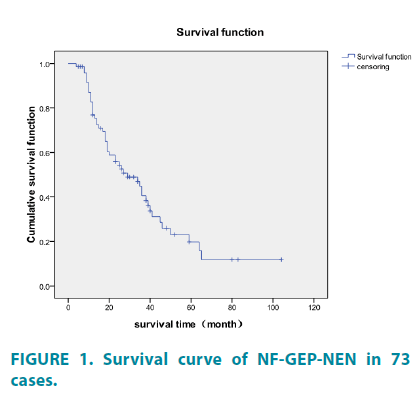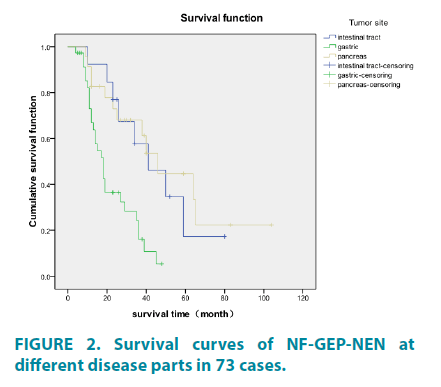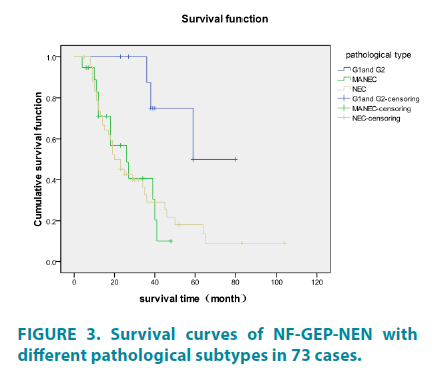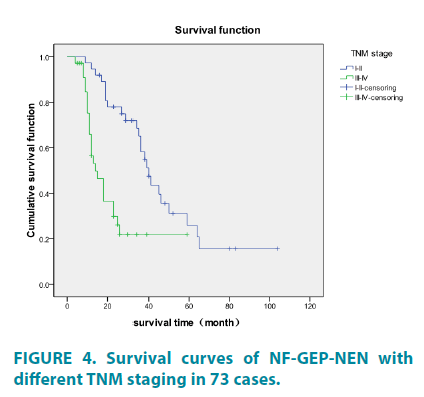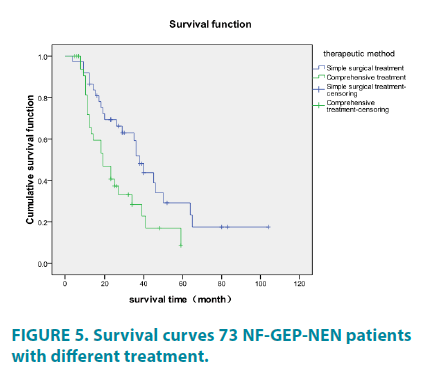Research Article - Clinical Practice (2017) Volume 14, Issue 3
The clinical characteristics and prognosis of 73 patients with Nonfunctional Gastroenteropancreatic neuroendocrine neoplasm: a 10-year retrospective study of a single center
- Corresponding Author:
- Xiushen Wang
Department of Radiotherapy, Tumor Hospital Affiliated to Zhengzhou University Henan Cancer Hospital,
Zhengzhou, 450008, China
E-mail: wangxiushen1218@163.com ; bushaner@aliyun.com
Abstract
Gastroenteropancreatic neuroendocrine neoplasms (GEP-NENs) which originated from peptidergic neurons of the digestive tract and neuroendocrine cells constitute a rare and heterogeneous group of tumors with varied biology. Because of the concealment of symptoms in mostly nonfunctional GEP-NENs, the difficult early diagnosis challenging reduced the chances of curative surgery, and decreased patients’ survival. This study analyzed 73 patients diagnosed with nonfunctional GEP-NENs between July 2004 and May 2015, including the clinical characteristics, treatment outcome and survival of patients, which aimed to prepare a practical guide to be used in common clinical practice. SPSS 17.0 was use to analyze the statistical significance. The median age of the 73 patients was 58 years, 50 were men. 5 patients were classified as NEN G1 (n=5; 6.8%), 6 were G2 (n=6; 8.2%), 43 were neuroendocrine carcinoma (NEC) (n=43; 58.9%), and 19 were MANEC (n=19; 26.0%). Most cases were diagnosed with III-IV tumors at presentation (n=42; 57.5%), although the majority of well-differentiated GEP-NENs (G1 and G2) were diagnosed with earlier stage I and II (n=7; 70%). Operation based on comprehensive treatment were performed in most patients (n=64; 87.7%), while the other 9 cases underwent radiotherapy or chemotherapy simply. The median follow-up period was 37 months. The overall 3-year and 5-year survival were 76.9% and 40.5%. In the univariate analysis, higher stage according to the AJCC/UICC classification (P<0.001), NEC (P=0.016), male (P<0.001), old age (P<0.001), location in gastric (P<0.001), and non-operative treatment (P=0.013) were associated with poorer prognosis. In standardized multivariate models, higher stage (P<0.001), and male (P=0.018) were independent risk factors for death. The most important factors affecting survival of patients with nonfunctional gastrointestinal pancreatic neuroendocrine neoplasm are sex and tumor stage.Keywords
gastrointestinal tract, pancreatic, neuroendocrine neoplasm, clinical features, survival
Background
Gastroenteropancreatic neuroendocrine neoplasms (GEP-NENs) are highly heterogeneous groups of a tumor, which capable of producing 5-HT metabolites or active peptide, such as glucagon, insulin, gastrin, corticosteroid etc. Sometimes they may present as relatively indolent, while sometimes as highly aggressive and rapidly metastasizing characteristics, especially in nonfunctional GEP-NENs neoplasm (NF-GEP-NEN) [1- 3]. The nonfunctioning and not be related to specific symptoms creates the early diagnosis of nonfunctional GEP-NENS challenge, reduces the chances of curative surgery, and decreases patient survival. This retrospective analysis aimed to analyze the data from our clinical center in 10 years, and concern the clinicopathological features, diagnostic methods, therapeutic methods and prognosis of NF-GEP-NEN.
Resources and Methods
Clincal information
73 patients (50 men, 23 women) who were pathologically diagnosed with NF-GEP-NEN and treated in Henan Cancer Hospital from July 2004 to March 2015 were collected. All cases underwent chest, abdomen and pelvic CT scans, and pathological analysis. IHC required as at least one diffuse or strong positive of regular Synaptophysin (Syn) detection and Chromogranin A (CgA). According to WHO 2010 criteria for GEP-NEN, the cell proliferation index used the Ki-67 index, the grading of G1, G2 and G3 was less than or equal to 2%, 3-20% and greater than 20%, respectively. Tumors with mitotic rates of less than two under 10 HPF were classified as G1; those with rates from 2 to 20 in 10 HPF were G2, and those with rates greater than 20 in 10 HPF were G3. If the grading of the Ki-67 index disagreed with the mitotic rate, the higher of the two priorities. Neuroendocrine carcinomas (NEC) including large cell NEC and small cell NEC had different shapes and sizes, and a moderate amount of cytoplasm, in which nuclear division was readily observed. The mixed adenoneuroendocrine carcinomas (MANEC) consisted of both adenocarcinoma and neuroendocrine carcinoma cells, and the proportion of each was need more than 30 percent. The American Joint Committee on Cancer /Union for International Cancer Control (AJCC/UICC) developed the staging systems for GEP-NENs in 2009, based on the TNM scoring system (Tumor size, Lymph Nodes affected, Metastases). All patients have signed the consent to allow the use of their clinical data for research.
Treatment approaches
Most patients underwent operation based on comprehensive treatment (n=64; 87.7%), and the other cases received chemotherapy simply (n=9, 12.3%). Among of the operation patients, 24 cases underwent the postoperative chemotherapy, while only one case received postoperative irradiation due to the invasion of surrounding tissues, who received IMRT on the pelvic by 50Gy/25f, and then the local tumor volume (rectal) by 60Gy/30f/6w. Most chemotherapy was primarily managed with the EP regimen consisting of cisplatin (DDP, 20 mg/m2, days 1-5), etoposide (VP-16, 60-100 mg/m2, days 1-5), repeated every 3-4 weeks.
Follow-up data and statistical method
Follow-up was long term by visits or calls in all cases. The overall survival time calculated from the day of diagnosis to the last follow-up or the time of death. Follow-up time ended at March 2015; the median follow-up was 37 months. SPSS 17.0 was use to analyze the statistical significance. Kaplan-Meier was used to calculate survival rate, Log-rank for significant test of survival rate, Cox proportional hazards regression models for multivariate analysis with inspection level α=0.05.
Results
Clinical features
Among the 73 cases enrolled in this study, the median age was 58 years old with a range from 28 to 85 years old, 50 were man. Primary tumor sites: 37 stomach (50.7%), 23 pancreases (31.5), 9 rectums (17.8%), 1 small intestine, 2 colon, 1 appendix. First symptoms: 44 cases presented abdominal discomfort like pain or distention (60.3%), 7 difficulty swallowing or discomfort (9.6%), 11 hematemesis or melena (15.1%), 3 malaise (4.1%), 2 hypoglycemia (2.7%), 3 stool change (4.1%), 2 physical findings (2.7%), 1 lumbar back pain (1.4%). WHO classification: five patients were G1 (6.8%), six were G2 (8.2 %), 43 were NEC (58.9%), and 19 were MANEC (26.0%). AJCC/UICC classification: stage I (15/73; 20.5%), stage II (16/73; 21.9%), stage III (31/73; 42.5%), stage IV (11/73; 15.1%).
Result of IHC
Among the 73 cases, Syn positive showed in 94.4% of patients, and CgA positive was 66.7%. Syn and CgA detection double positive took a percentage of 61.1%. Expression of Syn and CgA in different pathological classified cases listed in Table 1.
| Projects | Cases | Syn + (%) | CgA+ (%) | Syn+ &CgA + (%) |
|---|---|---|---|---|
| Histopathological type | ||||
| G1 | 5 | 100 | 80 | 80 |
| G2 | 6 | 100 | 60 | 60 |
| NEC | 43 | 90.6 | 65.1 | 58.1 |
| MANEC | 19 | 100 | 68.4 | 68.4 |
| Total | 73 | 94.4 | 66.7 | 61.1 |
| Note: G1: neuroendocrine tumors grade 1; G2: neuroendocrine tumors grade 2; NEC: neuroendocrine carcinoma; MANEC: mixed adenoneuroendocrine carcinoma |
||||
Table 1: Imunohistochemical results of NF-GEP-NEN in 73 cases.
Follow-up and prognosis
The data from all follow-up cases was collected. The median follow-up time for these patients was 37 months, 9 patients still alive before the end of study. The median overall survival time was 29 months, with a range from 4 to 104 months. 3- and 5-year survival rates were 40.5% and 19.8%, respectively (Figure 1). An analysis was performed on the sex, age, primary tumor site, histopathological grading, TNM stage, treatment to identify the prognostic factors associated with survival. Univariate analysis confirmed female and young cases were present better prognosis; patients with tumor located in pancreas had a higher 3- and 5-year survival rate of 68.0% and 44.6%; and the early TNM stages better than the advanced stages (Table 2). Compared to the intestinal origin, gastric origin cases had the worst prognosis (equal to 16.770,P<0.001) (Figure 2). Based on pathological classification of NF-GEP-NEN, NET(G1 and G2), NEC, MANEC, 3-year and 5-year survival rate were 87.5% and 50.0%, 29.0% and 18.1%、40.6% and 10.2% (equal to 8.223,P=0.016) (Figure 3). Survival rate in patients with stage I-II were 65.0% and 25.9% respectively, significantly higher than those with stage III-IV (equal to 15.724 ,P<0.001) (Figure 4). 3-year and 5-year survival rates of surgery alone had a survival rate of 51.8% and 29.1%, significantly higher than that received chemoradiotherapy (equal to 6.192,P=0.013) (Figure 5). 3-year and 5-year survival rates of different pathological diameters listed in Table 2. According to the Cox hazard regression model, which removed the confounding factors, multivariate analysis showed the gender and TNM staging had an impact on the overall survival for NF-GEPNEN (Table 3).
| Clinical characteristics | Cases(%) | Survival rate(%) |  |
P | ||
|---|---|---|---|---|---|---|
| 3 years | 5 years | |||||
| Sex | Male | 50(68.4) | 21.3 | 8.1 | 15.001 | <0.001 |
| Female | 23(31.6) | 78.3 | 43.7 | |||
| Age (year) | ≥58 | 37(50.7) | 17.2 | 0 | 21.129 | <0.001 |
| <58 | 36(49.3) | 63.2 | 41.6 | |||
| Tumor site | gastric | 37(50.7) | 16.2 | 5.4 | 16.774 | <0.001 |
| pancreas | 23(31.5) | 68.0 | 44.6 | |||
| intestinal tract | 13(17.8) | 57.5 | 17.3 | |||
| TNM stage | Ⅰ-Ⅱ | 29(39.7) | 65.0 | 25.9 | 15.724 | <0.001 |
| Ⅲ-Ⅳ | 44(60.3) | 21.8 | 21.8 | |||
| Treatment method | Simple surgical | 37(50.7) | 51.8 | 29.1 | 6.192 | 0.013 |
| Comprehensive | 36(49.3) | 28.4 | 8.5 | |||
| Pathological type | G1 and G2 | 10(13.8) | 87.5 | 50.0 | 8.223 | 0.016 |
| NEC | 43(59.7) | 29.0 | 18.1 | |||
| MANEC | 19(26.5) | 40.6 | 10.2 | |||
Table 2: Relationship between the clinical features and survival rates of NF-GEP-NEN in 73 cases.
| Clinical parameter | B | SE | Wald | df | Sig. | Exp(B) | 95.0% CI | |
|---|---|---|---|---|---|---|---|---|
| Sex | -1.007 | 0.427 | 5.567 | 1 | 0.018 | 0.365 | 0.158 | 0.843 |
| Age | -0.679 | 0.364 | 3.478 | 1 | 0.062 | 0.507 | 0.249 | 1.035 |
| Treatment method | 0.108 | 0.354 | 0.093 | 1 | 0.761 | 1.114 | 0.557 | 2.227 |
| Pathological type | 2.045 | 2 | 0.360 | |||||
| TNM stage | -1.521 | 0.420 | 13.145 | 1 | 0.000 | 0.218 | 0.096 | 0.497 |
| Tumor site | 4.025 | 2 | 0.134 | |||||
Table 3: Multivariate analysis with Cox proportional hazards regression model.
Discussion
GEP-NEN is rare tumor and studies have revealed its rising morbidity in past 30 years [1,2,7], cases of NF-GEP-NEN in Henan Cancer Hospital increased from 19 in 2005- 2009 to 54 in 2010-2014, this increase could be attributed to the proper diagnosis more accurately with the modern medical technology. All 73 NF-GEP-NEN patients including their disease location, clinical manifestation, pathological type, clinical staging and treatment were discussed in the study. According to the available research data, most NF-GEP-NEN originates from stomach, followed by pancreas and rectum, while small intestine, colon and appendix are seldom, which presented discrepancy with some other data. Some study reported that within the Asian population, GEP-NEN mostly occurred in pancreas, while gastrointestinal-NEN mostly occurred in the rectum, followed by stomach and appendix, jejunum, and ileum took less than 3%, colon appeared to have the lowest morbidity [3-8]. According to a research report made by National Cancer Institute in 2008, in Northern America, rectum and ileum were common locations for NENs, with pancreas in third, but rarely located in stomach as reported. Henan Province is a high incidence of gastric cancer area. The possible reason is the poor eating habits, including eating moldy food, drinking, favorite salted and hot food, water and food in the high nitrite composition. Of course, do not rule out the genetic factors [9,10]. Most stomach NFNEN accidence maybe related to these reasons above, although there is no scientific evidence to support this hypothesis. Many previous studies have already elucidated the poor prognosis of NEC in the stomach [21,22], even some study confirmed that NEC, MANEC in stomach showed poorer outcome than gastric carcinomas with <10% neuroendocrine differentiation or without neuroendocrine morphology [23], which consistent with our study.
This data showed that most cases appeared with stomachache symptom first, followed by abdominal distension, swallowing discomfort, hematemesis etc. As in other studies, the clinical manifestations appeared no specificity and probably related to NF-NEN caused hormone shortage, but generally resulting from large tumor mass or metastasis [9,10]. Lack of specificity endangers its clinical diagnosis, which requiring further diagnosis with ultrasonography, CT scan and EUS for NF-GEP-NEN, while its final diagnosis still relied on tissue slices or surgical samples, including cellular morphology and IHC. Syn expression spreads widely in the cytoplasm of NEN cells, which appears diffuse positive. CgA also expresses in cytoplasm, but has a poor sensitivity. Syn has a higher sensitivity than CgA in diagnosing GFP-NET, but CgA has definite guiding significance in making prognostic judgment of GEP-NEN [11,12].
Therefore, it is necessary to simultaneously Syn and CgA in making GEP-NET diagnosis. Cases in this group confirmed as neuroendocrine tumor by pathological characteristics, among the 73 cases, Syn is positive in 94.4% of the cases, while of Syn and CgA together were positive in 61.1% of the cases reported here.
Although there has various ways of treating GEP-NEN, most studies promoted surgery in the early stage [13-15]. Surgery alone presented a better prognosis than combined treatment in NF-GEP-NEN, which probably connected with the relatively early staging of cases who received surgery alone. As most GEP-NEN patients present distant metastasis at first visit, commonly liver and bone, which is nearly impossible for radical surgery, the best therapeutic model is multidisciplinary treatment, including chemotherapy, biotherapy, targeted therapy and radiotherapy all occupy a certain position, which reveals prominent effect in recent studies, making themselves candidates as standard first-line therapy [16]. In addition, some experts proved radionuclide therapy to be an effective way to improve the life span of patients [17]. Only one rectal NEN case received postoperative radiotherapy that is still alive now, survival time 25 months before the end of the follow-up. Due to the limited number of cases, radiotherapy is not included as contributory factor, therefore the effect and disease free survival rate of radiotherapy in treating NFGEP- NEN requires further investigations.
In our study, the 5-year overall survival was19.8%, which is substantially worse than other studies (5-year survival of 40%-60%) [18]. More malignant NEC were involved perhaps was the reason. The univariate survival analysis demonstrated worse prognosis with a higher stage, NEC, male, old, location in gastric and nonoperative treatment, confirming literature data on the association between the length of survival and both the extent of the disease at diagnosis and the histopathological type of the tumor [4,8,18]. In standardized multivariate models, high stage and male were the independent risk factors for poor outcome. According to Garcia-Carbonero et al, independent risk factors were grading and staging at diagnosis [19]. Other reports, including a summary of the Surveillance, Epidemiology, showed longer survival rates among women than among men, which is consistent with our study [20-23].
In conclusion, due to the lack of specific clinical manifestation, early diagnosis of NF-GEPNEN has a certain difficulty. Comprehensive imaging and IHC might support early diagnosis. Comprehensive treatment based on operation takes on an essential part in treating NFGEP- NEN, but the concrete treating method prolonging the disease free survival rate requires further research.
Conclusion
The most important factors affecting survival of patients with nonfunctional gastrointestinal pancreatic neuroendocrine neoplasm are sex and tumor stage. The analysis of single-center data improves identification of patients with poorer prognosis requiring a more aggressive approach.
Declarations
Authors have no conflict of interest.
References
- Yao JC, Hassan M, Phan A, et al. One hundred years after "carcinoid": epidemiology of and prognostic factors for neuroendocrine tumors in 35,825 cases in the United States. J.Clin.Oncol. 26(18),3063-3072(2008).
- Alsina M, Marcos-Gragera, Capdevila J, et al. Neuroendocrine tumors: a population-based study of incidence and survival in Girona Province, 1994-2004.Cancer Epidemiol. 35(6),e49-54(2011).
- Zeng YJ, Liu L, Wu H, et al. Clinicpathological features and prognosis of gastroenteropancreatic neuroendocrine tumors: analysis from a single-institution. Asian Pac. J. Cancer Prev. 14(10),5775-5781(2011).
- Lim T, Lee J, Kim JJ, et al. Gastroenteropancreatic neuroendocrine tumors: incidence and treatment outcome in a single institution in Korea. Asia Pac. J.Clin.Oncol. 7(3),293-299 (2011).
- Wang YH, Lin Y, Xue L, et al. Relationship between clinical characteristics and survival of gastroenteropancreatic neuroendocrine neoplasms: A single-institution analysis (1995-2012) in South China. BMC Endocr.Disord.12,30(2012).
- Lewkowicz E, Trofimiuk-Müldner M. Gastroentero-pancreatic neuroendocrine neoplasms: a 10-year experience of a single center. Pol. Arch. Med.Wewn. 125(5),337-346(2015).
- Tsikitis VL, Wertheim BC, Guerrero MA. Trends of incidence and survival of gastrointestinal neuroendocrine tumors in the United States: a seer analysis. J. Cancer 3,292-302(2012).
- Zwan JM, Trama A, Otter R, et al. Rare neuroendocrine tumours: Results of the surveillance of rare cancers in Europe project. Eur. J. Cancer. 49(11),2565-2578(2013).
- Ramage JK, Ahmed A, Ardill J, et al. Guidelines for the management of gastroenteropancreatic neuroendocrine (including carcinoid) tumours (NETs). Gut. 61(1),6-32(2012).
- Turaga KK, Kvols LK. Recent progress in the understanding, diagnosis, and treatment of gastroenteropancreatic neuroendocrine tumors. CA Cancer J.Clin. 61(2),113-132(2011).
- Jianu CS, Fossmark R, Syversen U, et al. A meal test improves the specificity of chromogranin A as a marker of neuroendocrine neoplasia. Tumor Biol. 31(5),373-380(2010).
- YE Bi-Xing, LIN Lin. The diagnostic and prognostic value of chromogranin A and synaptophysin in gastroenteropancreatic neuroendocrine tumors. Chin. J. Dig. 32(1),29-32(2012).
- Yucel B, Babacan N A, Kacan T, et al. Survival analysis and prognostic factors for neuroendocrine tumors in Turkey. Asian Pac. J. Cancer Prevx. 14(11),6687-6692(2012).
- Ganetsky A, Bhatt V. Gastroenteropancreatic neuroendocrine tumors: update on therapeutics. Ann.Pharmacother. 46(6),851-862(2012).
- Schott M, Kloppel G, Raffel A, et al. Neuroendocrine neoplasms of the gastrointestinal tract. Dtsch.Arztebl. Int. 108(18),305-312(2011).
- Hou-jie L, Chen Y. Interpretation consensus on treatment of gastroenteropancreatic neuroendocrine neoplasm. Chin.Clin.Oncol. 16(11),1039-1043(2011).
- Delpassand ES, Samarghandi A, Zamanian S, et al. Peptide Receptor Radionuclide Therapy with 177Lu-DOTATATE for Patients With Somatostatin Receptor-Expressing Neuroendocrine Tumors: The First US Phase 2 Experience. Pancreas. 43(4),518-525(2014).
- Lepage C, Ciccolallo L, et al. Epidemiology of carcinoid neoplasms in Vaud, Switzerland, 1974-97. Br. J. Cancer. 83(7)952-955(2000).
- Garcia-Carbonero R, Capdevila J, Crespo-Herrero G, et al. Incidence, patterns of care and prognostic factors for outcome of gastroenteropancreatic neuroendocrine tumors (GEP-NETs): results from the National Cancer Registry of Spain (RGETNE). Ann.Oncol. 21(9),1794-1803(2010).
- Lepage C, Bouvier AM, Faivre J. Endocrine tumours epidemiology of malignant digestive neuroendocrine tumours. Eur. J. Endocrinal. 168(4),R77-83(2013).
- La Rosa S, Inzani F, Vanoli A, et al. Histologic characterization and improved prognostic evaluation of 209 gastric neuroendocrine neoplasms. Hum.Pathol. 42,1373-1384(2011).
- Ishida M, Sekine S, Fukagawa T, et al. Neuroendocrine carcinoma of the stomach: morphologic and immunohistochemical characteristics and prognosis. Am. J. Surg.Pathol. 37,949-959(2013).
- Park JY, Ryu MH, et al. Prognostic significance of neuroendocrine components in gastric carcinomas. Eur. J. Cancer. 50,2802-2809(2014).
